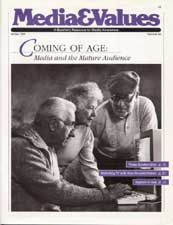CHILDREN: Media Help Fill Grandparent Gap
|
This article originally appeared in Issue# 45
|
Today's children are more likely to have living grandparents and perhaps great-grandparents than youngsters a century ago. But distance, estrangement, death, even work (yes, the elderly work, too) separate many children from their grandparents. Media can provide a link.
Current programming portraying aging adults is beginning to show them as three-dimensional individuals with ideas, interests, emotions and energy. Shows like Our House, The Golden Girls, and even Captain Kangaroo provide a variety of models for children to consider. Children whose contact with older relatives is limited, especially, can benefit from learning to know TV's grandparents and enjoying their relationships with their television families.
After watching a program that presents images of aging, discuss those images with children. Explore the relationship of aging to illness, death and activity levels, and use the media to verify that older people lead active lives.
Questions for discussion might focus on the healthy variety shown on the screen. What do TV's grandparents have in common? How are they different? Would the child like to have them for grandparents? How are they like or different from his or her own older relatives? What have they learned in their years of living that their TV grandchildren don't know?
Families with no close older relatives can use acquaintance with TV "grandparents" as a springboard for getting to know actual old people: visiting nursing homes, making videotapes, writing letters or talking by computer with faraway grandparents. Contact need not be all in one direction; many grandparents would be happy to send audio or videotapes as a special message to grandchildren.
Family or class "adopt a grandparent" programs can use TV characters to center discussions of the real people they meet.
Of course, the media alone cannot take the place of direct contact between children and the elderly. Children cannot experience the thrill of holding a wrinkled hand, the joy of an older person's smile greeting them or the mutual sharing of stories without developing a direct relationship. But in this age-segregated society it is all too easy for children to grow up in isolation from older individuals, depriving them of special friendships and the chance to understand the aging process. With proper guidance the media can help families take the first step toward bridging the gap.



